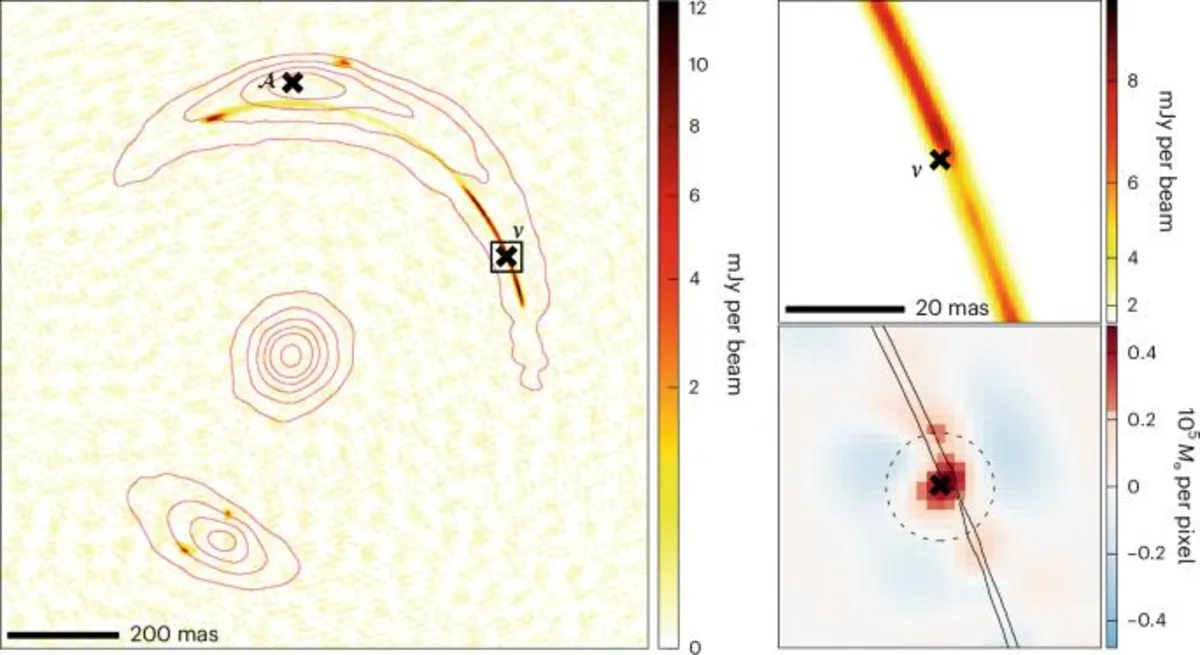
On subgalactic scales, the observational evidence supporting the ΛCDM cosmological paradigm remains inconclusive. This uncertainty arises from the complex and highly nonlinear interactions between baryons, radiation, and dark matter. One of the major challenges in conducting robust observational tests of the ΛCDM model in the low-mass regime (approximately ≲108 M⊙) is the inherent difficulty in characterizing the luminosities, sizes, and total masses of dim astronomical objects located at vast distances.
Low-mass luminous objects, including ultracompact dwarf galaxies and globular clusters, have thus far been directly observed only within the local Universe, reaching distances up to z ≈ 0.4. Meanwhile, other studies utilizing strong lensing by galaxy clusters have successfully detected dwarf galaxies, star clusters, and even individual stars at distances extending to z ≈ 10. However, it is crucial to note that these observations primarily focus on emitted light, necessitating that any constraints on the total mass of these objects be inferred indirectly.
Some low-mass entities are intrinsically dark, such as dark matter haloes and isolated intermediate-mass black holes, which are not expected to exhibit observable electromagnetic (EM) signatures. In this context, strong gravitational lensing presents a powerful alternative approach for studying low-mass objects that possess little to no EM luminosity. In a galaxy-scale strong lens system, a spatially extended source acts as a backlight for the gravitational landscape of its lens galaxy, unveiling low-mass perturbers solely through their gravitational influences.
Typically, lens galaxies fall within the redshift range of 0.2 ≲ z ≲ 1.5, allowing for the detection and study of low-mass, low-luminosity objects across cosmic time. To date, resolved observations of galaxy-scale lenses have identified three low-mass perturbers: an approximately 109 M⊙ detection in SDSS J0946+1006, an approximately 108 M⊙ detection in JVAS B1938+666 (the focus of this study), and another 109 M⊙ detection in SDP.81.
These discoveries were made using various high-resolution telescopes, including the Hubble Space Telescope (HST), W. M. Keck Observatory adaptive optics system, and the Atacama Large Millimeter Array (ALMA). Angular resolution remains a critical factor in the detection of low-mass perturbers, as the mass of a perturber determines a characteristic gravitational lensing length scale that must be adequately resolved.
JVAS B1938+666 is a notable strong lens system comprising an early-type galaxy at zl = 0.881, which lenses both optical and radio emissions from a source galaxy at zs = 2.059. In our analysis, we utilized a radio observation of JVAS B1938+666 conducted with a global very long baseline interferometry (VLBI) array at 1.7 GHz, achieving an angular resolution of approximately 5 mas.
In the radio spectrum, JVAS B1938+666 reveals a bright quadruply imaged feature, with two images merging into an extremely thin arc approximately 200 mas in length, alongside a fainter doubly imaged component. We employed a visibility-plane Bayesian forward-modelling technique to jointly infer both the pixellated source surface-brightness distribution and the lens mass model.
Initially, we modeled the lens mass distribution in a fully parametric manner to infer the large-scale mass distribution of the lens galaxy (the "macromodel"). We also included a truncated isothermal parametric mass component for the previously detected 108 M⊙ perturber, referred to as ℵ in this study. The VLBI observation of JVAS B1938+666 is sensitive to the presence of ℵ, demonstrating a Bayesian log-evidence of Δ log ℰ = +16 over a completely smooth macromodel without low-mass perturbers.
To search for additional low-mass haloes in JVAS B1938+666, we applied the gravitational imaging (GI) technique, which is a non-parametric method for identifying local overdensities in strong lens systems. Alongside the parametric macromodel and perturber ℵ, we detected a strong, compact correction to the surface mass density along the bright extended arc, which we denote as ℵ.
The detection of ℵ presents significant implications for the study of low-mass objects. Our findings indicate that if ℵ is a dark matter halo, its existence aligns with the anticipated number of detectable subhaloes in a ΛCDM cosmology. The probability of detecting at least one cold dark matter (CDM) subhalo in the 106, 107 M⊙ mass bin is p(n ≥ 1) = 0.65. Despite this, the density profile of ℵ may pose challenges, as further analyses suggest that the best-fit models for subhaloes exhibit concentrations significantly higher than predicted by simulations of CDM subhaloes.
In conclusion, this study highlights the capability of VLBI strong lens observations as a vital tool for discovering and accurately measuring the properties of low-luminosity objects in the 106 M⊙ mass regime at cosmological distances. The precision measurement of ℵ's mass, size, and position represents an unprecedented achievement in astrophysics, made possible through advanced observational techniques and state-of-the-art lens modeling software.